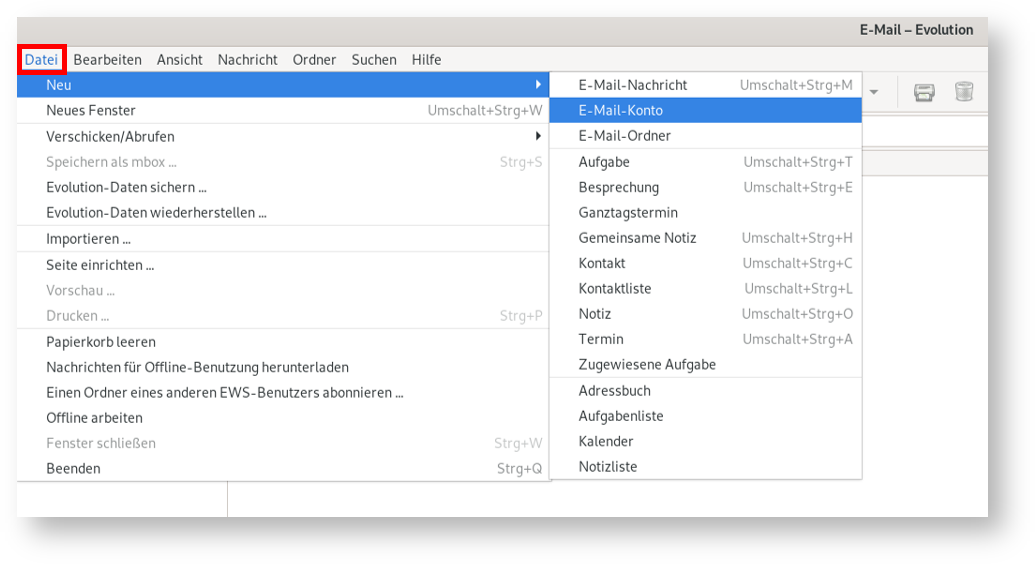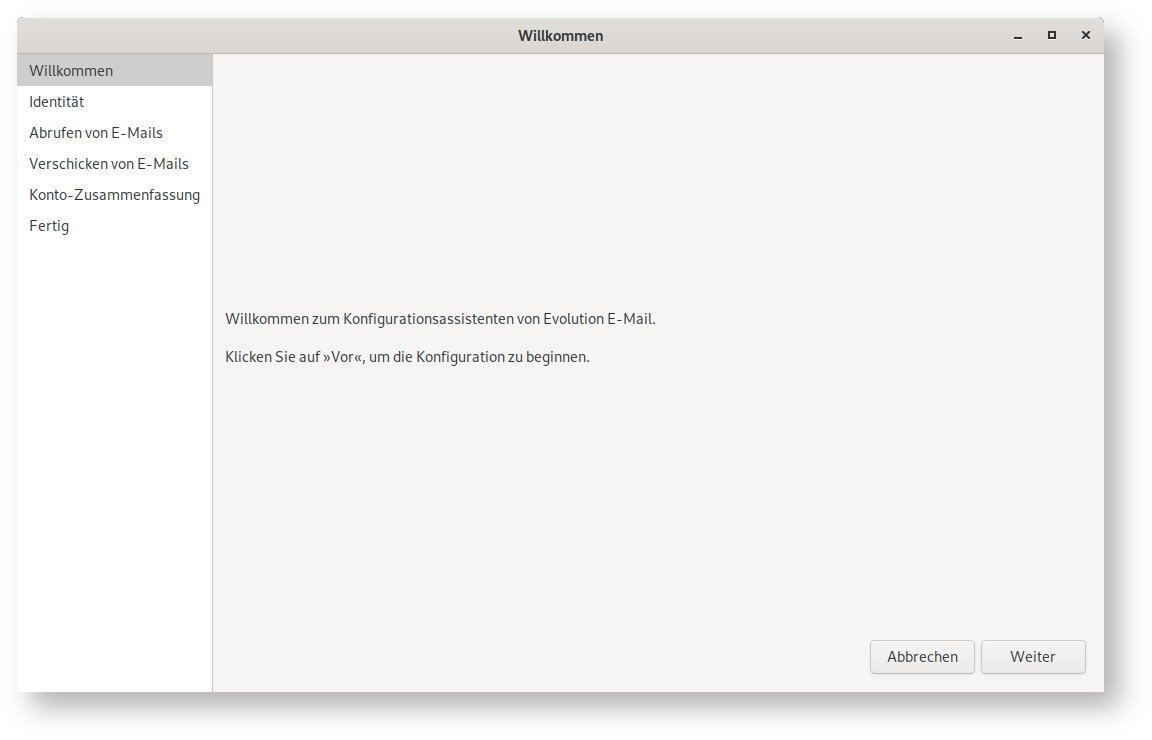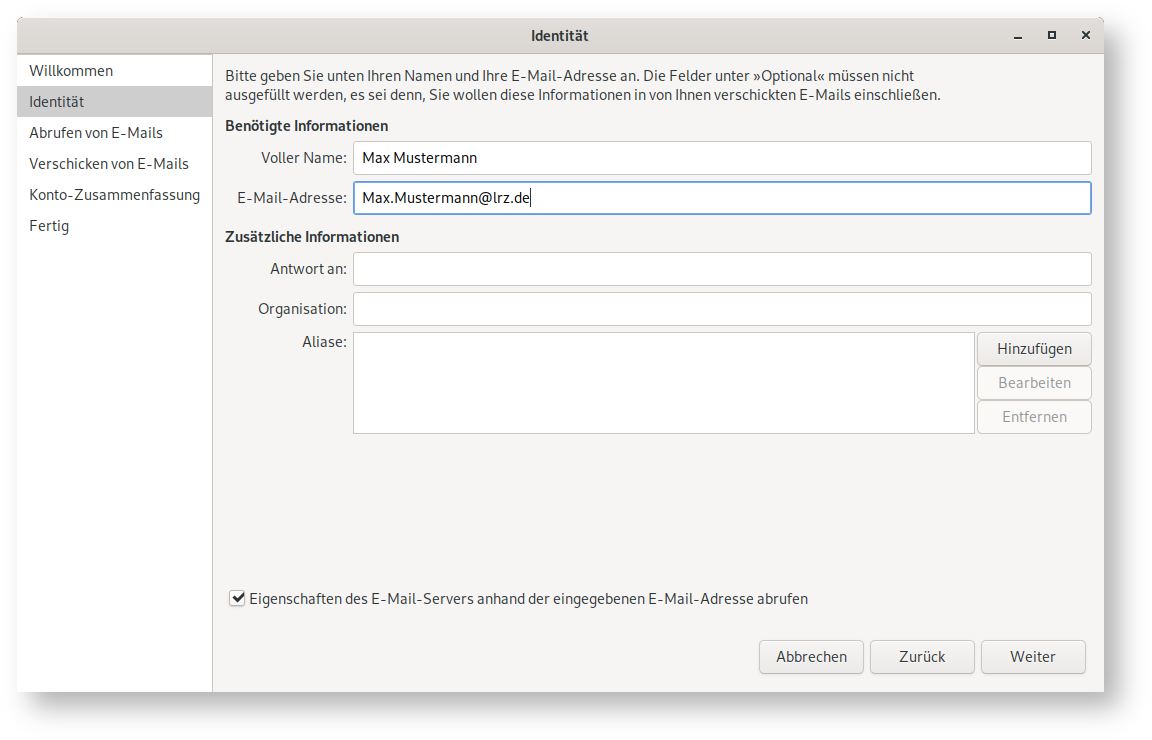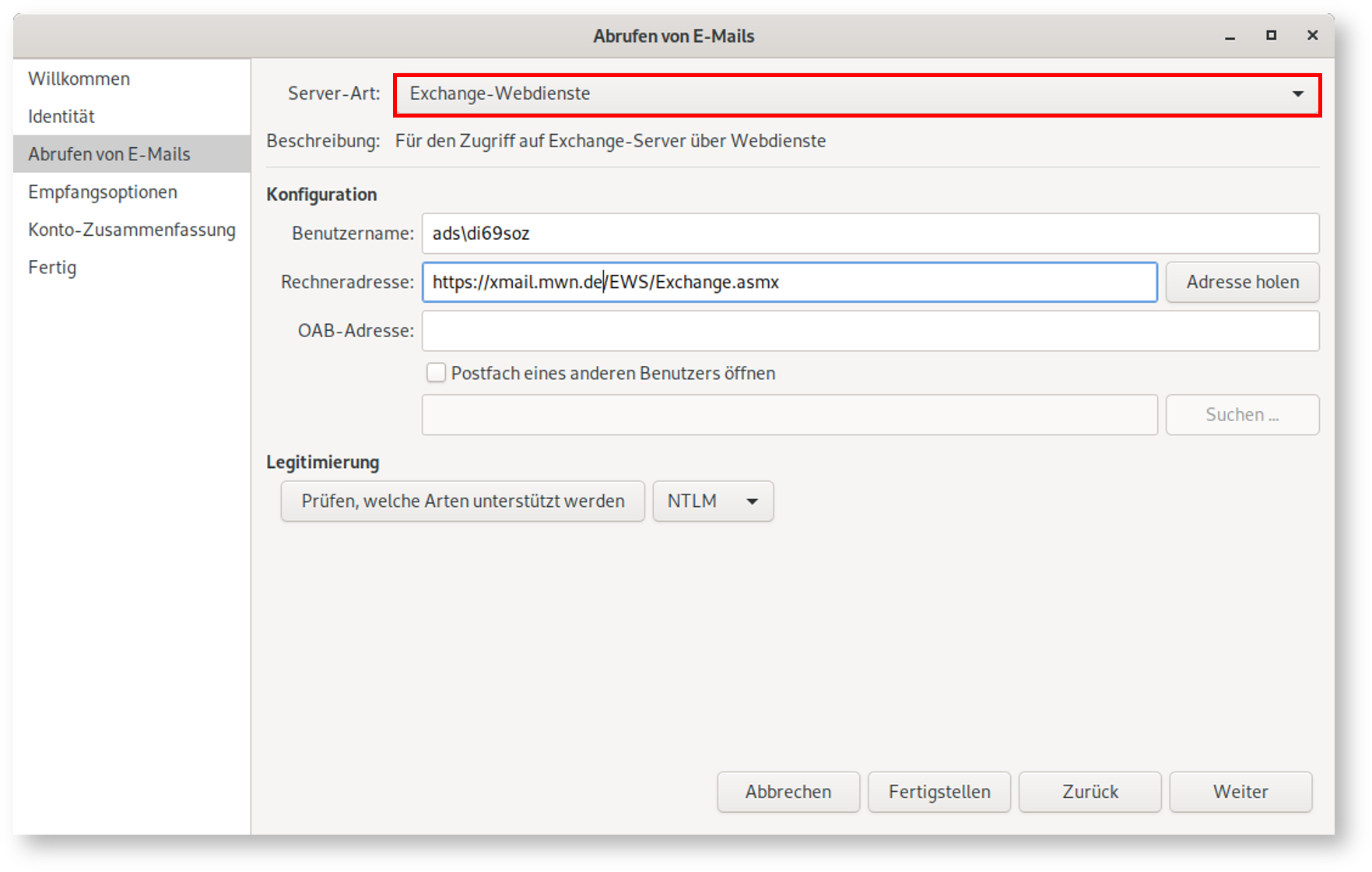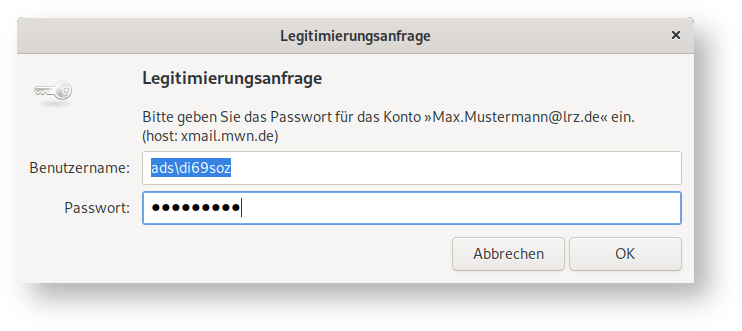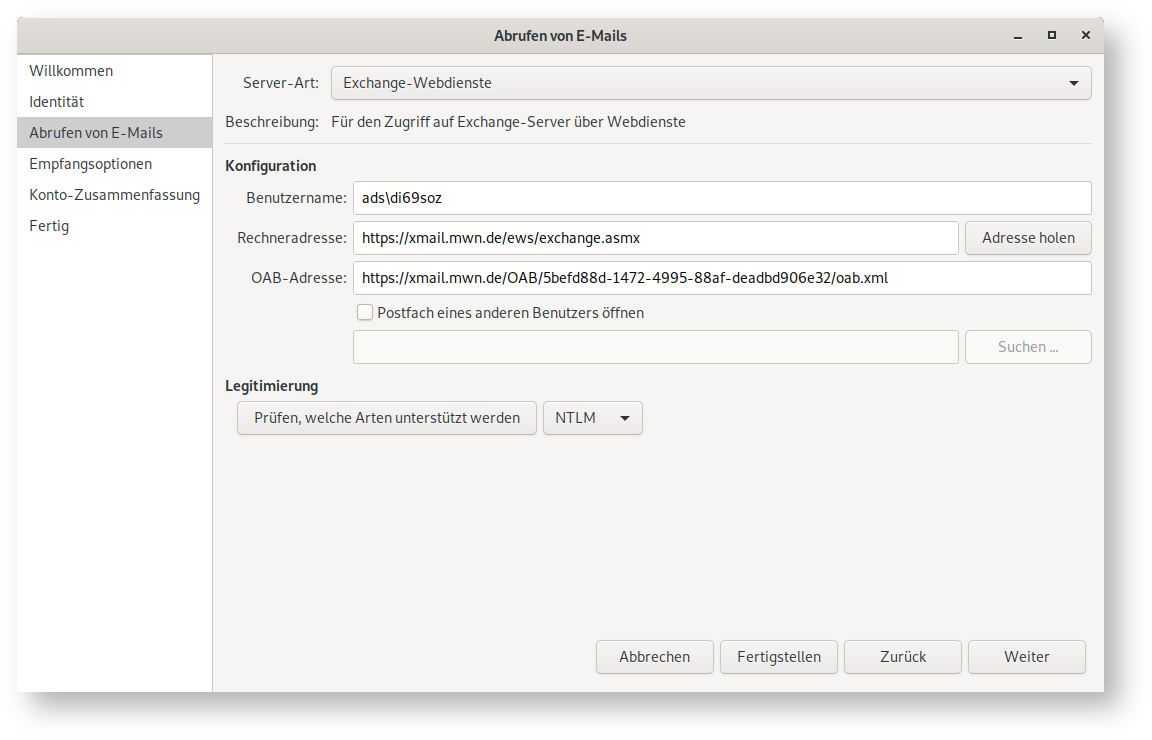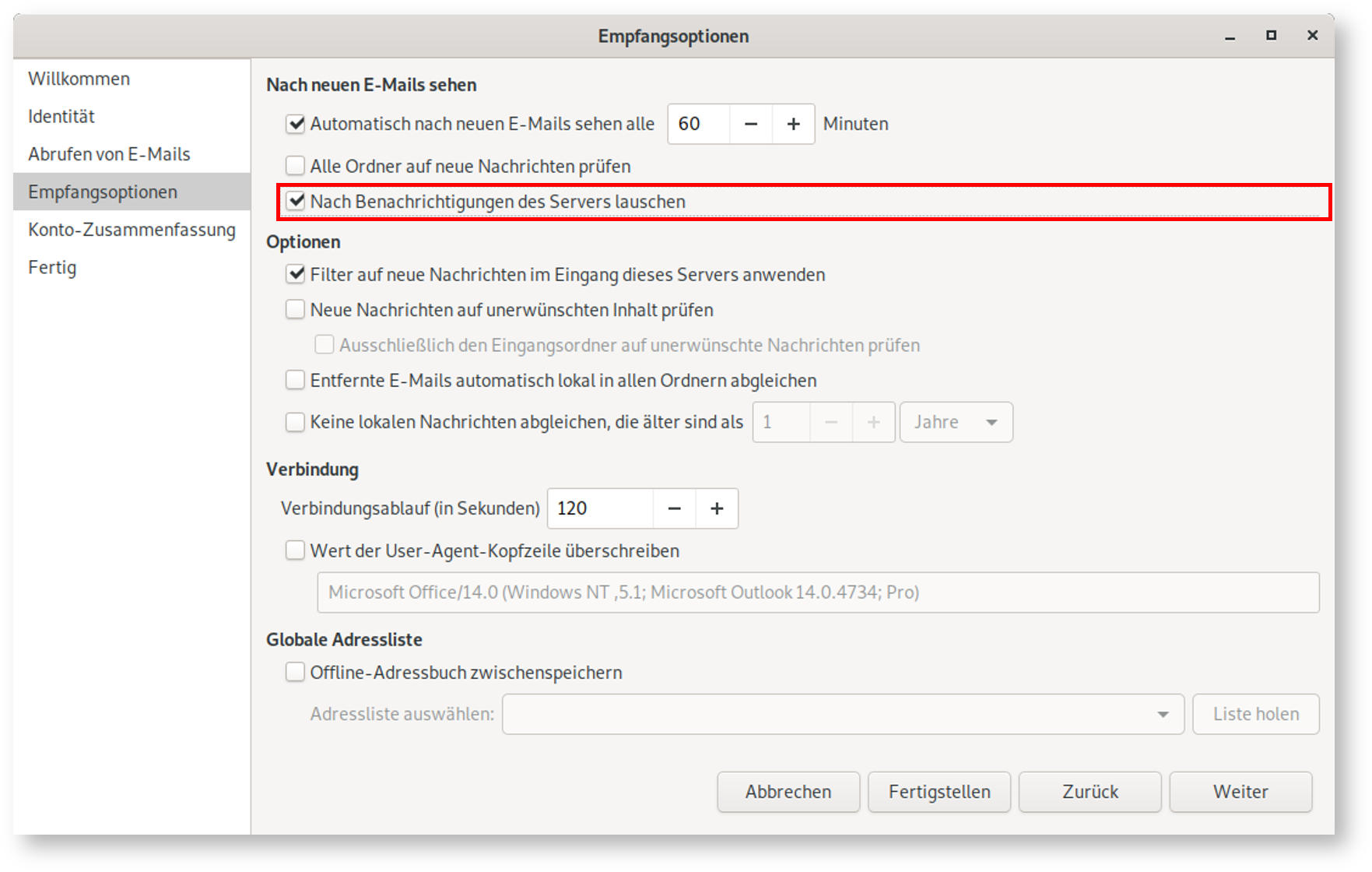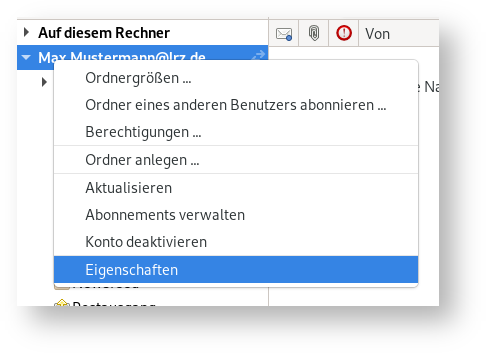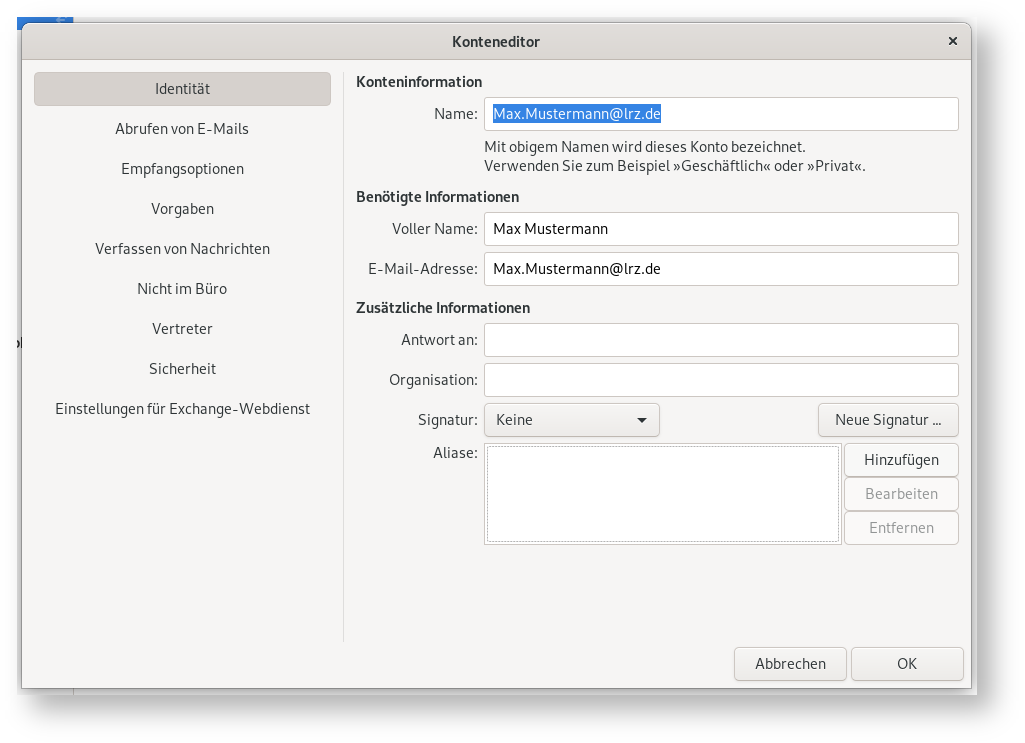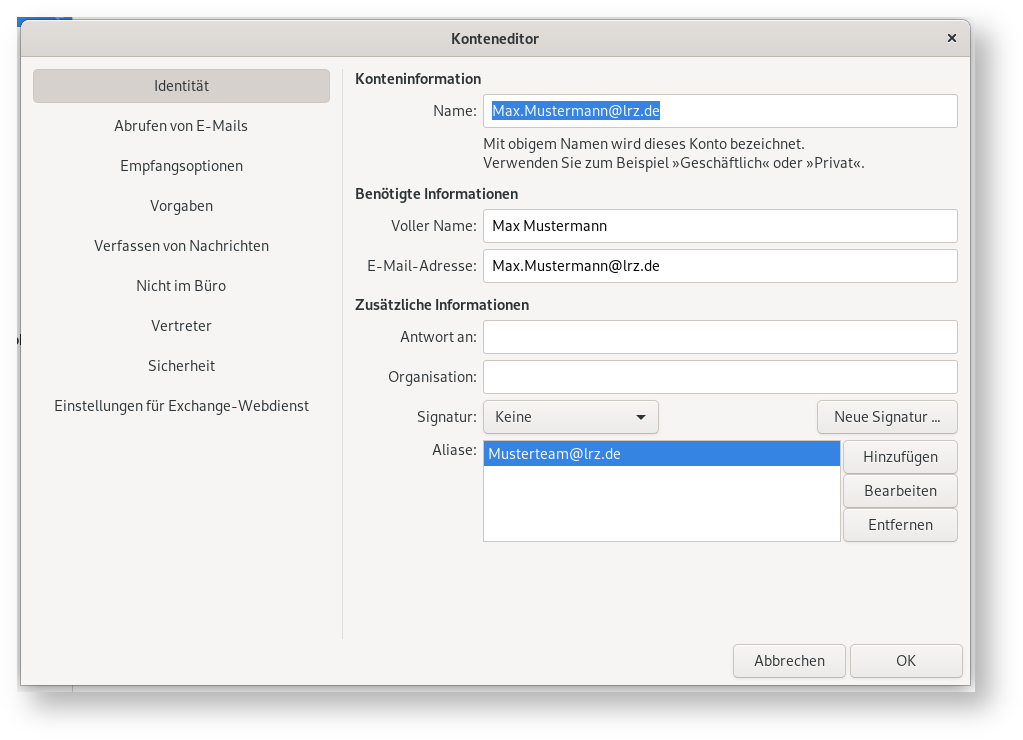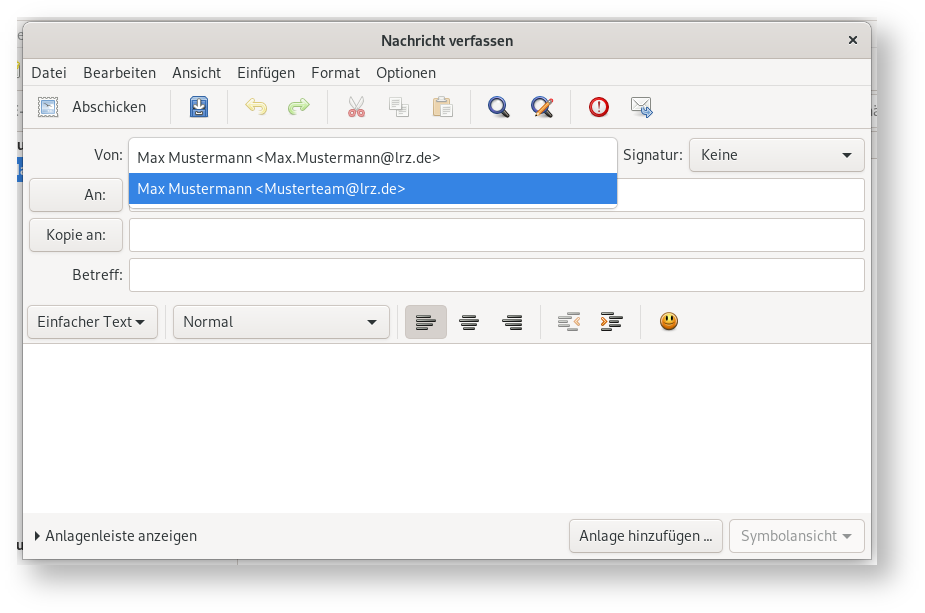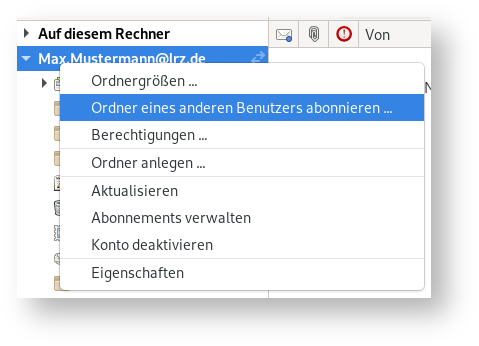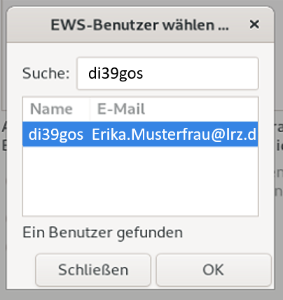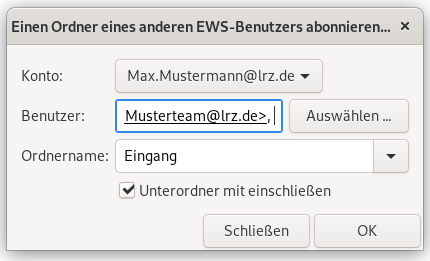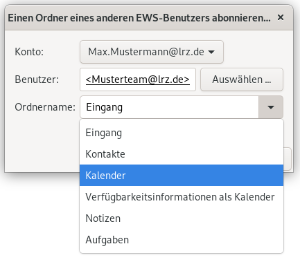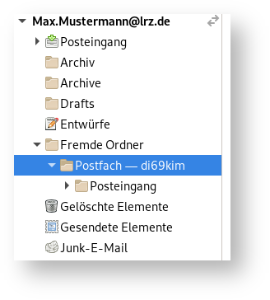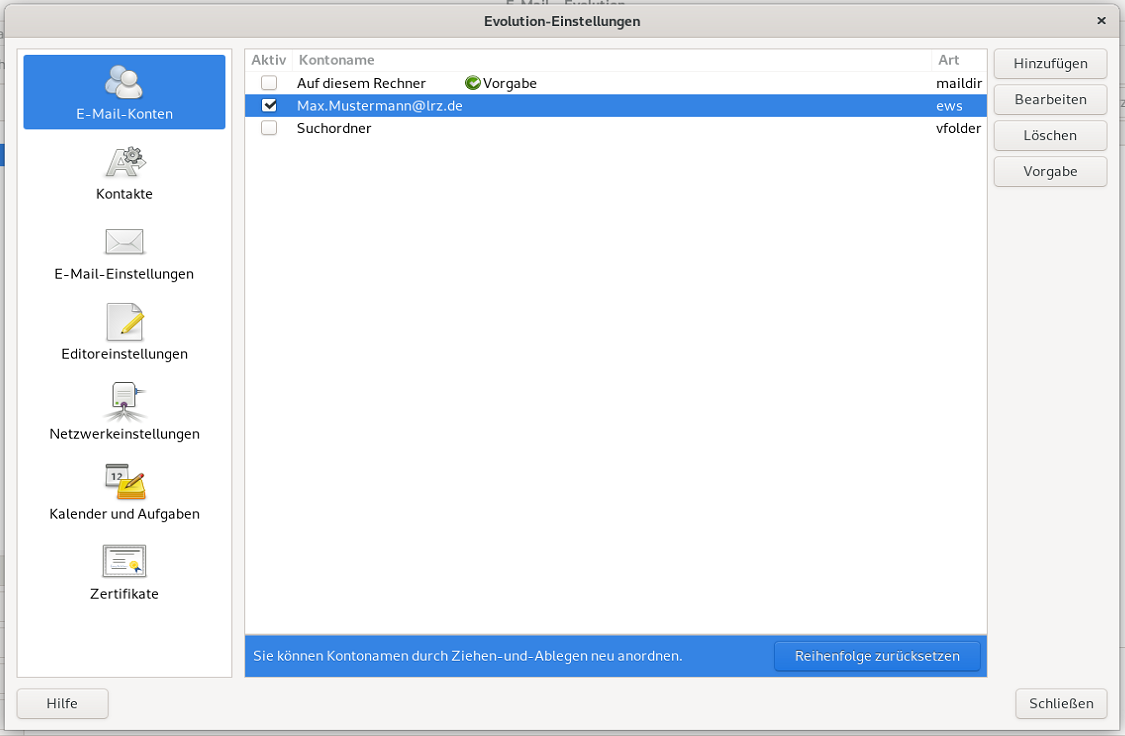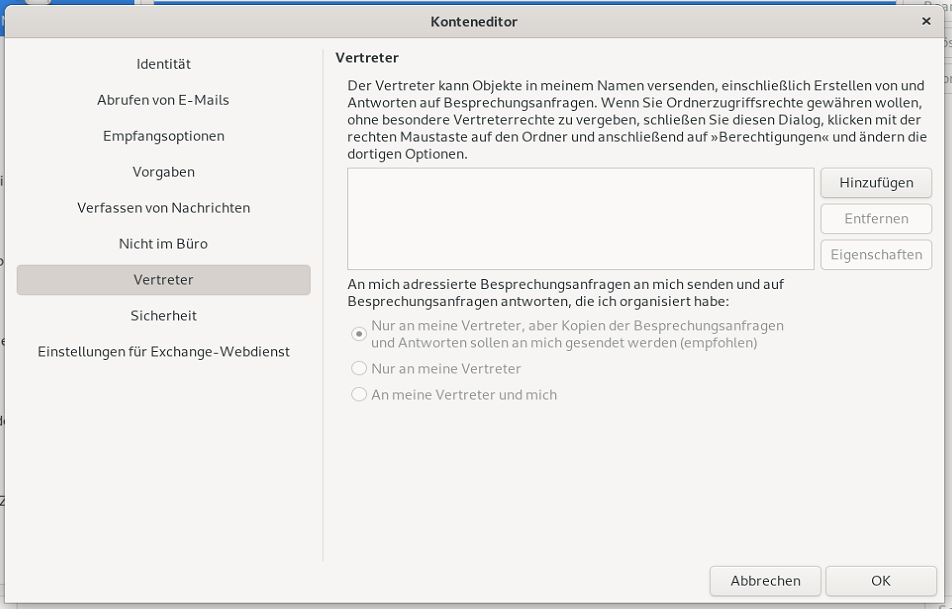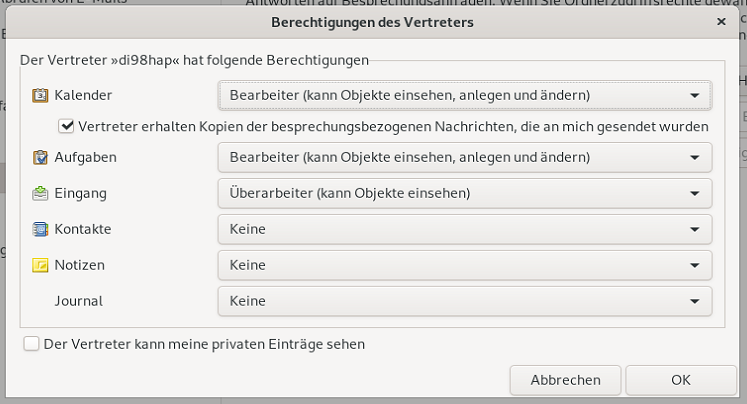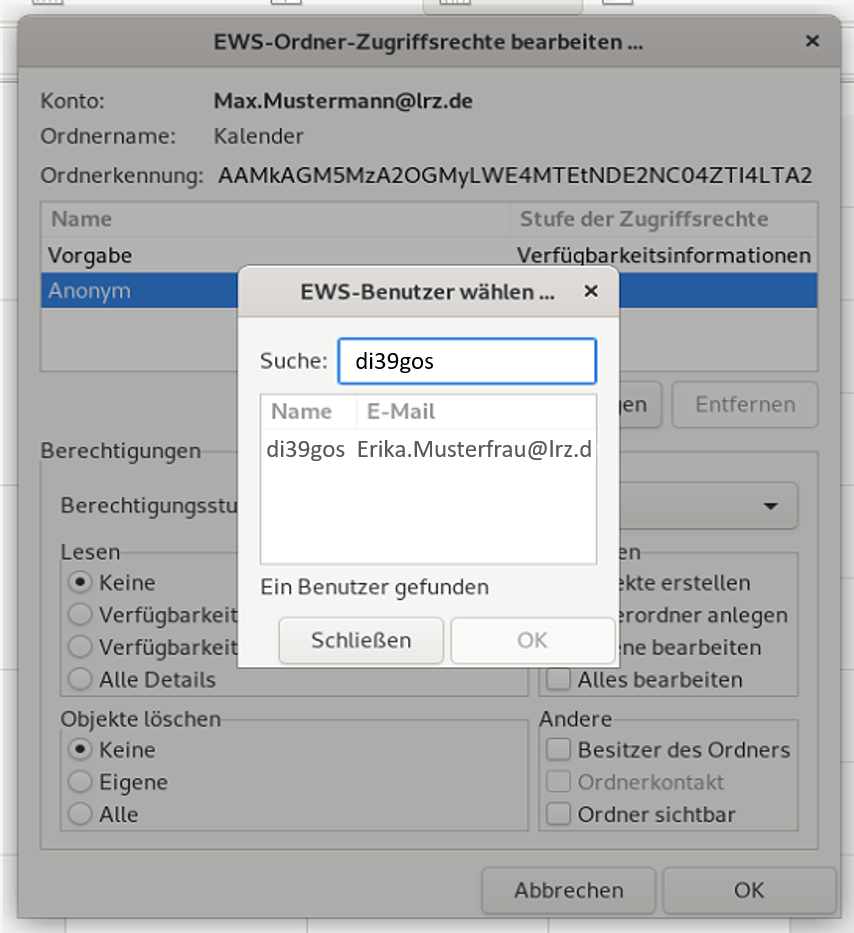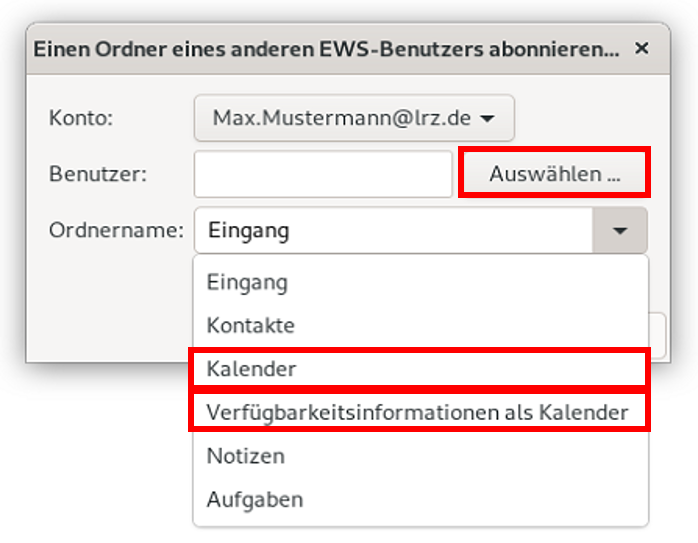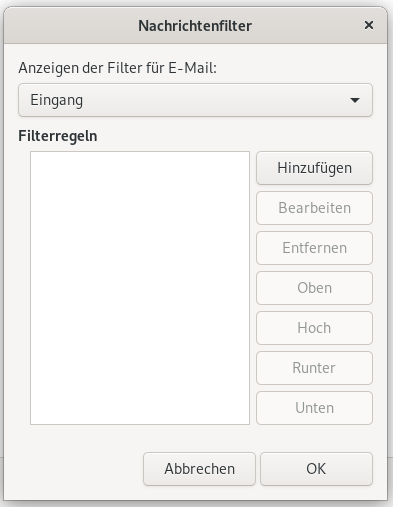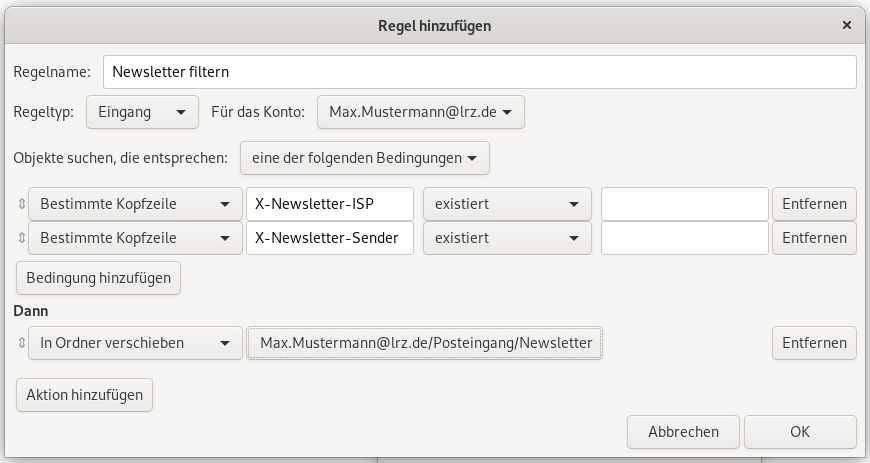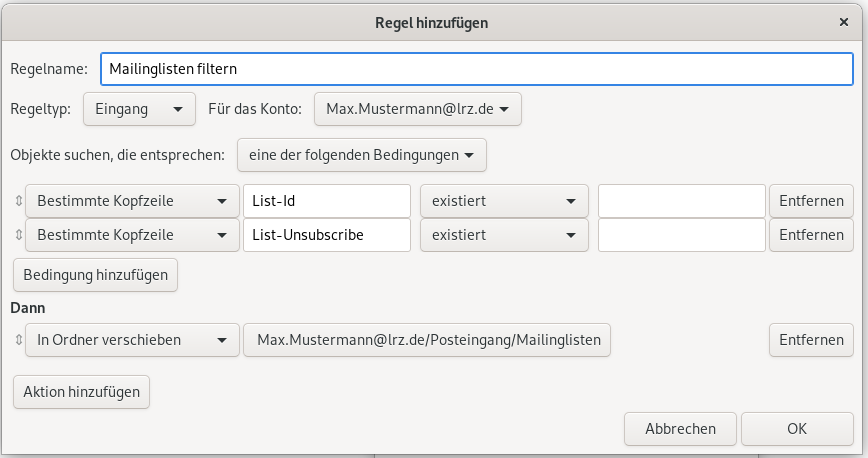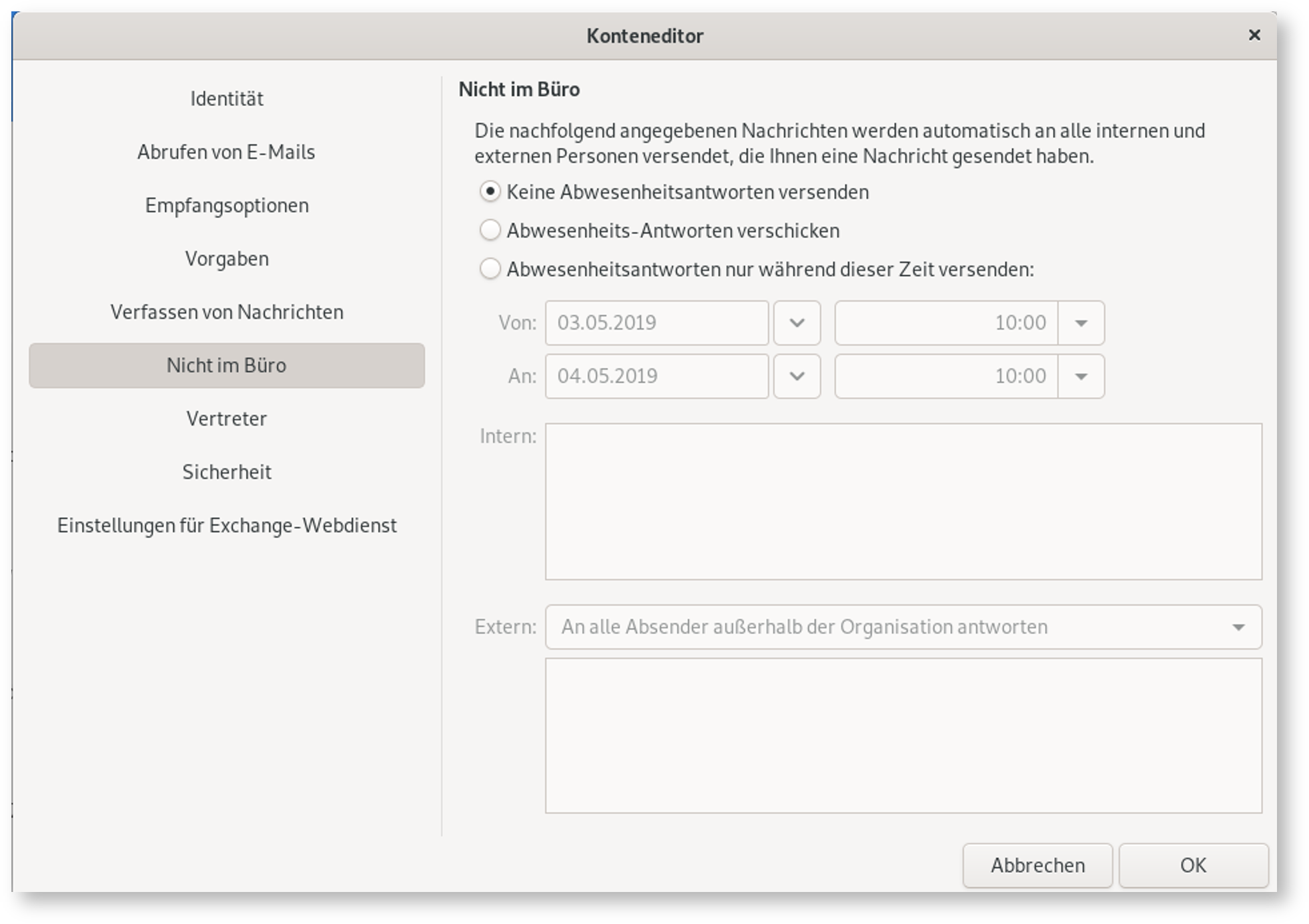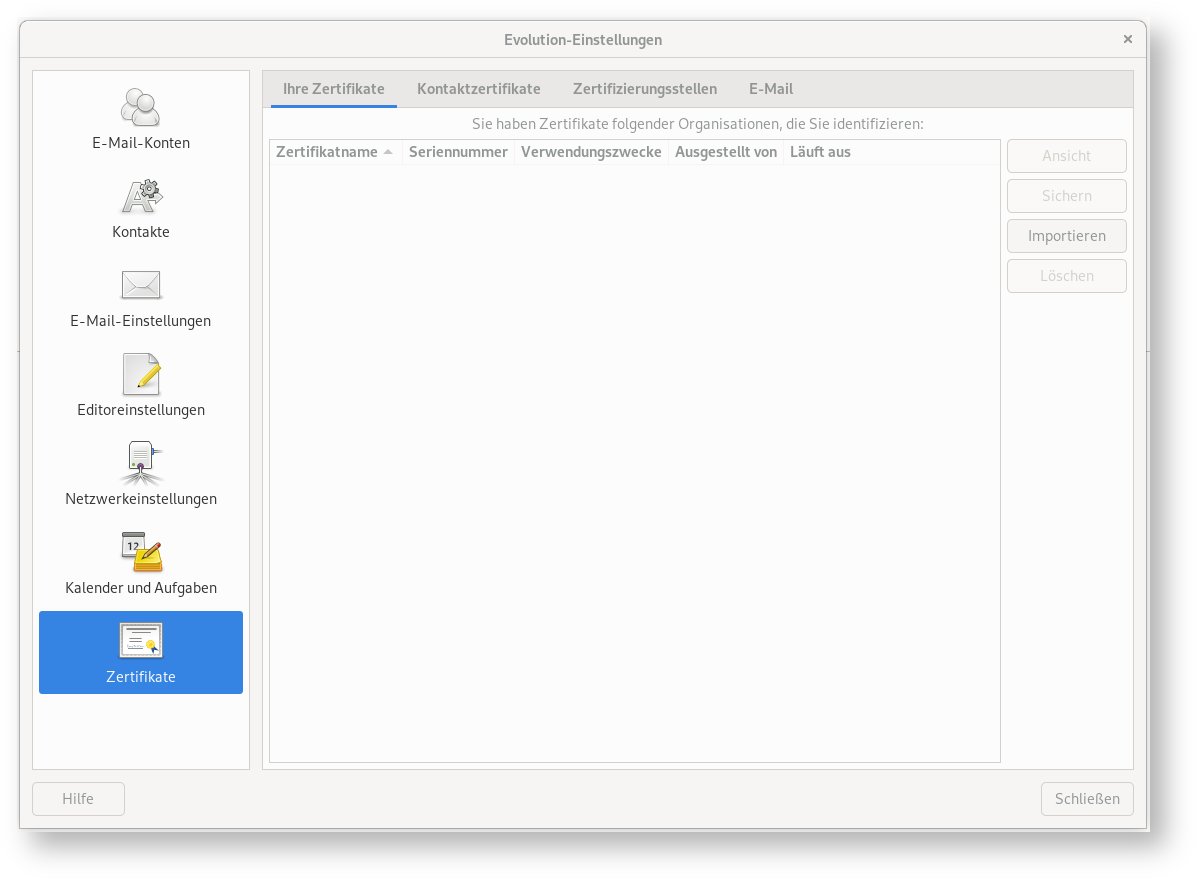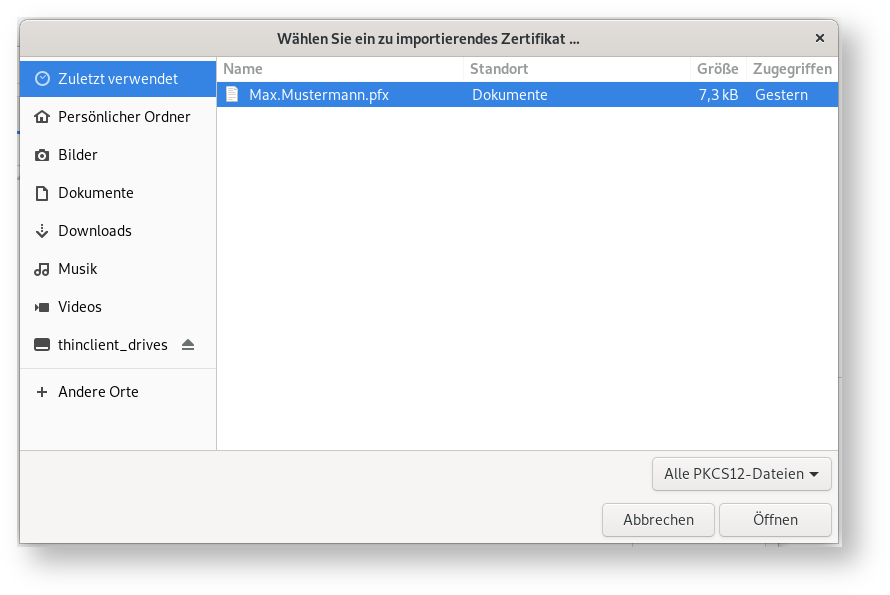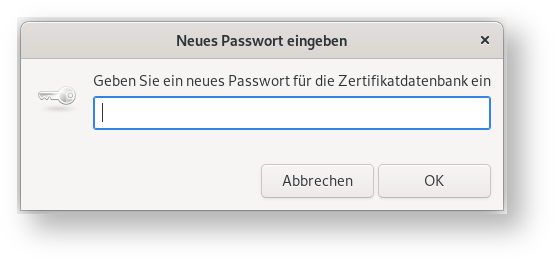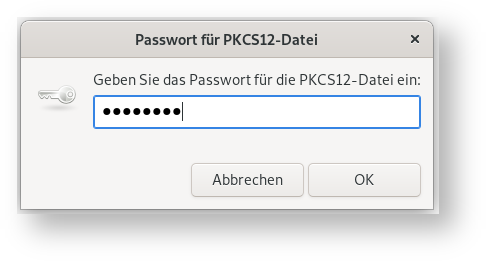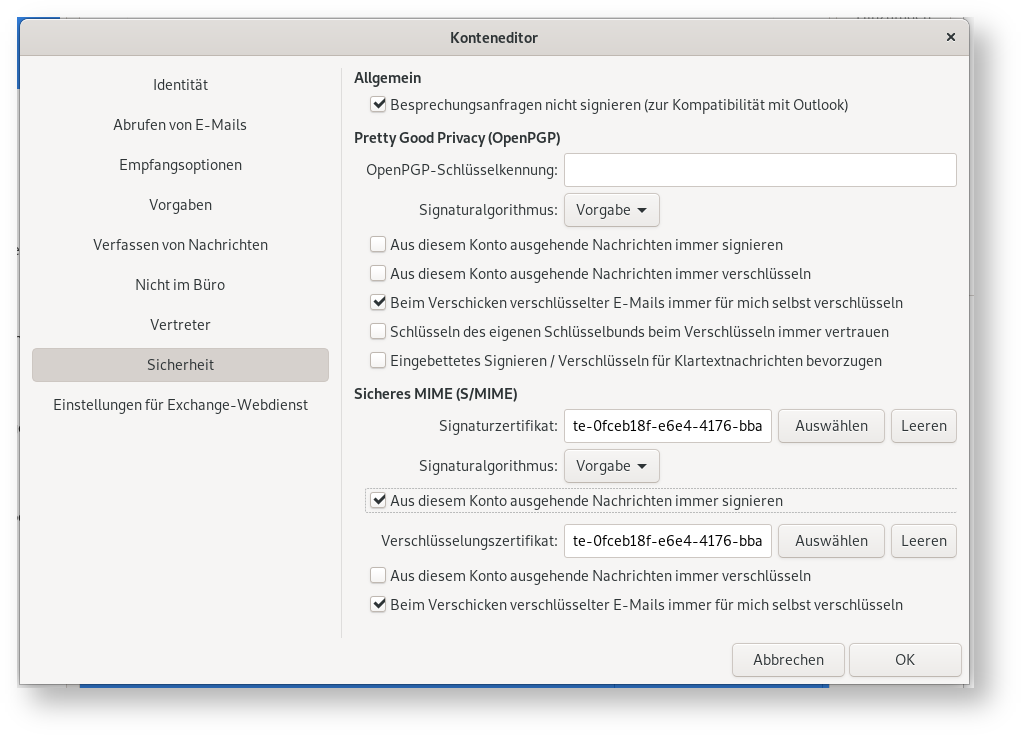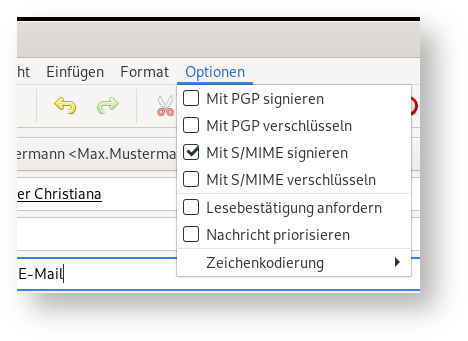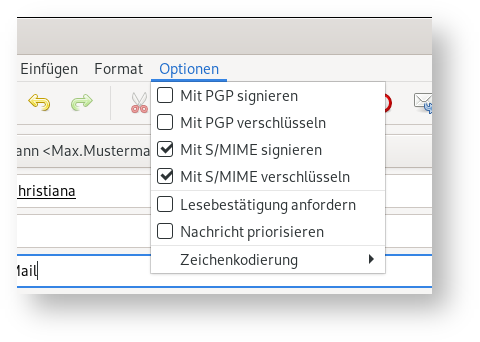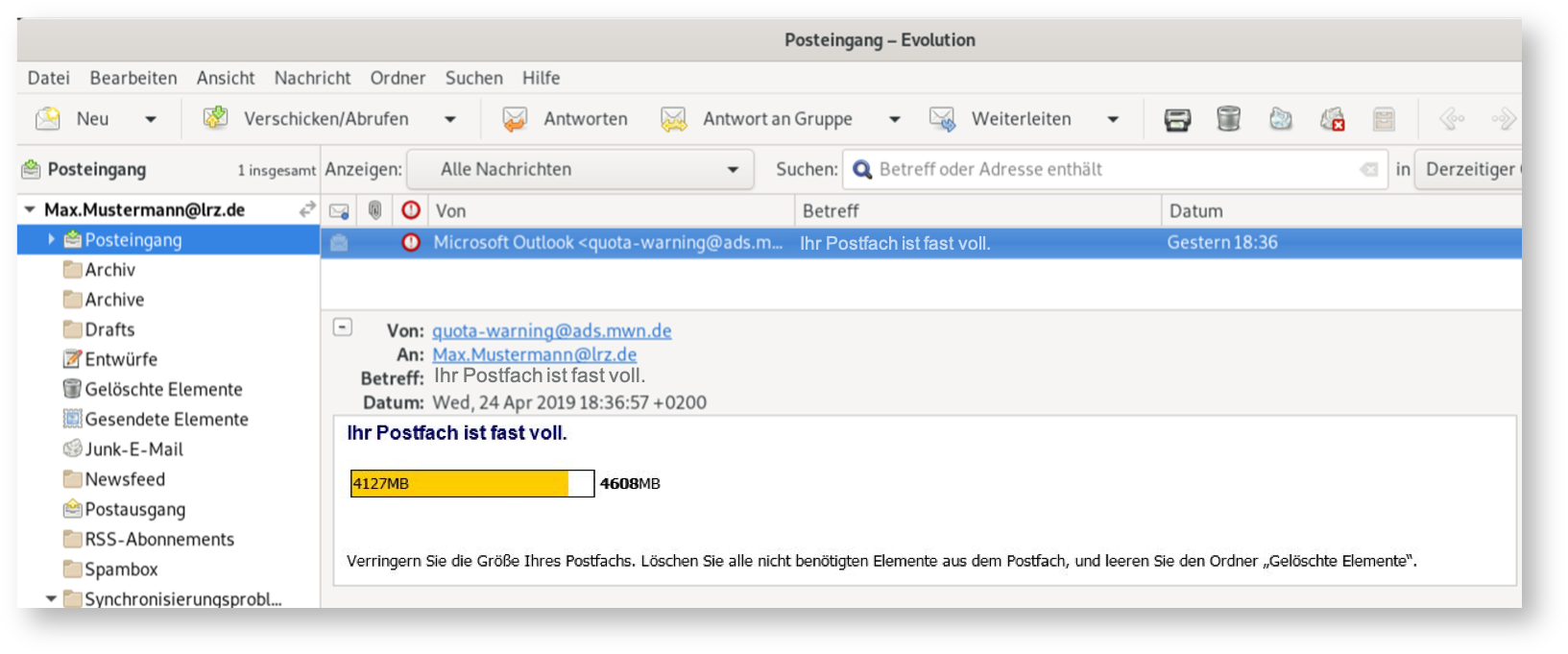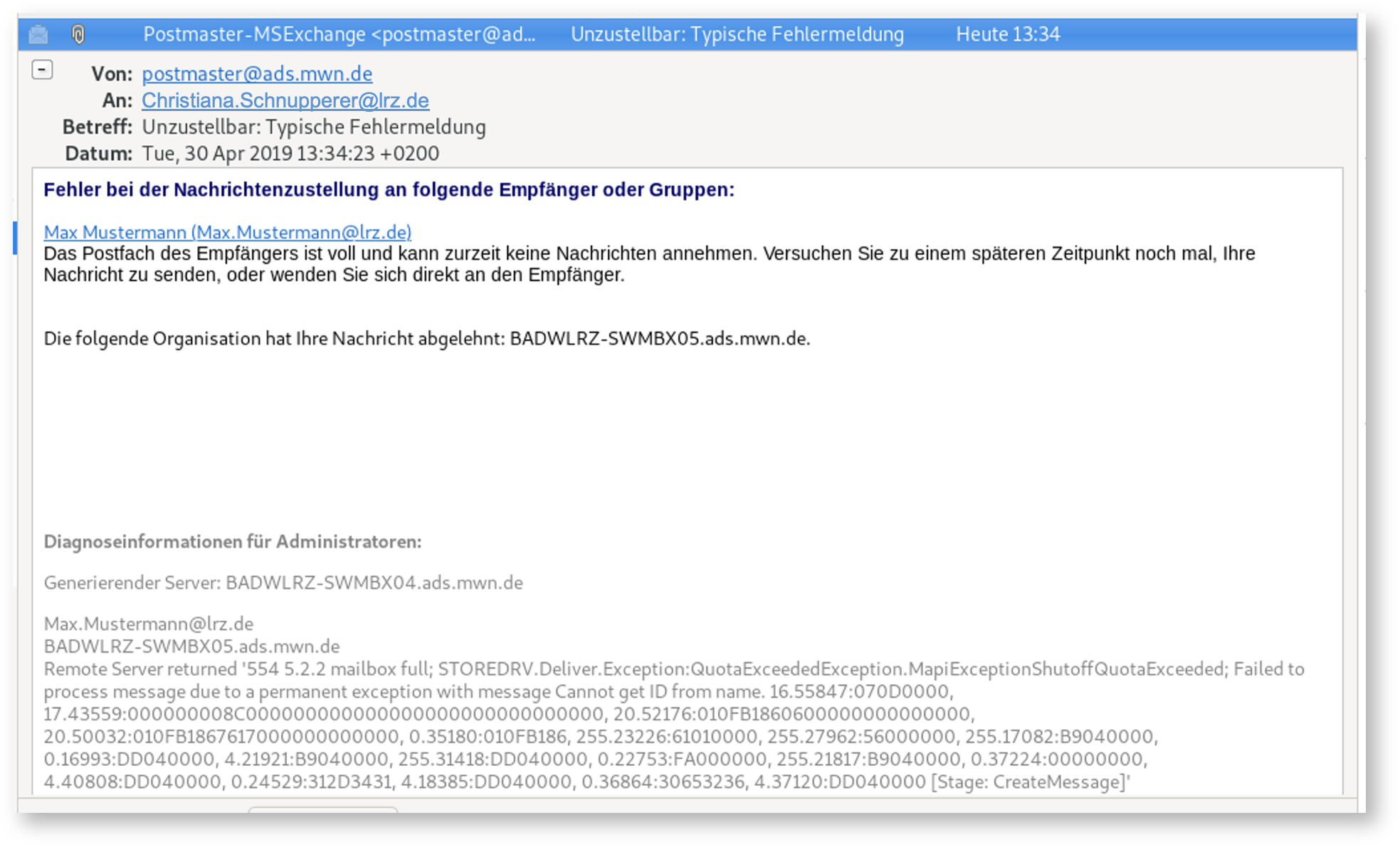Evolution (Linux)
Hinweis zur Barrierefreiheit
Diese Seite enthält bei Bildern/Grafiken alternative Texte.
Einrichtung
Wenn Sie das erste Mal Evolution starten bzw. noch kein Konto eingerichtet haben, wird automatisch ein Assistent gestartet, der Ihnen dabei hilft, Ihre E-Mail-Konten einzubinden.
Falls Sie bereits E-Mail Konten in Evolution eingebunden haben, können Sie den Einrichtungsdialog folgendermaßen starten:
Datei → Neu → E-Mail-Konto
... oder über die Einstellungen von Evolution:
Bearbeiten → Einstellungen
Geben Sie hier Ihren Namen und Ihre E-Mail-Adresse ein und bestätigen Sie mit "Weiter".
Wählen Sie hier bei "Server-Art" Exchange-Webdienste aus. Und geben Sie bei Benutzername Ihre Kennung mit einem vorangestellten " ads\ " ein.
Bei Rechneradresse müssen Sie folgendes angeben:
Klicken Sie auf Adresse holen, dann werden Sie nach Ihrem Passwort gefragt. Geben Sie dies ein und klicken Sie auf OK.
Nach der Authentifizierung wird automatisch der Pfad zum Offline-Adressbuch (OAB-Adresse) konfiguriert.
Damit die E-Mails automatisch vom Server abgerufen werden, setzen Sie den Haken bei "Nach Benachrichtigungen des Servers lauschen".
Im nächsten Schritt können Sie noch die Bezeichnung des Kontos in Evolution ändern.
Dann können Sie die Einrichtung abschließen.
Shared Mailbox
Shared Mailboxen bieten die Möglichkeit zur gemeinsamen Bearbeitung einer Mailbox. Anwendungsszenarien sind z.B. Funktionsadressen (wie info@domain.de) oder gemeinsame Lehrstuhlkalender (z.B. zur Urlaubsplanung) oder auch gemeinsame Kontakte des Lehrstuhls, die alle lesen dürfen bzw. die mehrere Personen gemeinsam verwalten.
In Evolution binden Sie eine Shared Mailbox nicht wie in Outlook als weitere Mailbox ein, sondern Sie abonnieren die einzelnen Ordner der Shared Mailbox. Eine Shared Mailbox wird also genauso eingebunden wie die freigegebenen Ordner eines/-r anderen Benutzers/-rin. Die Mailadresse der Shared Mailbox wird als Alias im eigenen Konto eingetragen. Dann können Sie beim Versenden einer E-Mail in einem Drop-down-Menü die gewünschte Absenderadresse auswählen.
Zuerst fügen Sie die Hauptmailadresse der Shared Mailbox als Alias hinzu. Öffnen Sie dazu die Eigenschaften, indem Sie einen Rechtsklick auf die oberste Ebene der Mailbox machen (hier: Max.Mustermann@lrz.de).
Klicken Sie dann unten rechts im Fenster auf "Hinzufügen". Geben Sie die Mailadresse der Shared Mailbox in die erschienene Zeile ein und klicken Sie auf "OK".
Wenn Sie jetzt eine E-Mail von der Shared Mailbox schreiben wollen, klicken Sie auf "Neu". Klicken Sie auf das Feld, in dem die Absenderadresse steht und wählen Sie dann die gewünschte Absenderadresse aus.
Anschließend abonnieren Sie die Mailordner. Machen Sie wieder einen Rechtsklick auf die oberste Ebene der Mailbox und wählen Sie dann "Ordner eines anderen Benutzers abonnieren..." aus.
Um nach der Shared Mailbox zu suchen, klicken Sie auf auswählen und geben Sie die Kennung oder E-Mailadresse ein und wählen Sie die Mailbox aus der Liste aus.
Wählen Sie dann bei "Ordnername" in dem Drop-Down-Menü "Eingang" aus, setzen Sie den Haken bei "Unterordner mit einschließen" und klicken Sie auf "OK".
Den Kalender der Shared Mailbox fügen Sie auf dem gleichen Weg hinzu, statt Eingang wählen Sie aber Kalender.
Die Abonnierten Ordner finden Sie dann in Ihrer Mailbox unter "Fremde Ordner". Dies ist dabei kein echter Ordner in Ihrer Mailbox. Die Entwickler von Evolution haben sich diese Art der Anzeige für geteilte Ordner ausgedacht. Bei anderen Clients oder in Ooutlook on the Web taucht "Fremde Ordner" nicht auf, dort wird eine andere Darstellung benutzt.
Stellvertretung
Stellvertreter:in eintragen
Öffnen Sie die Einstellungen und wählen Sie die das Konto aus, für das Sie eine:n Stellvertreter:in eintragen wollen.
Klicken Sie auf bearbeiten und wählen Sie dann in der Spalte auf der Linken Seite "Vertreter" aus. Klicken Sie dann auf hinzufügen.
Im nächsten Fenster suchen Sie nach der Person, die Sie vertreten soll. Suchen Sie dafür nach der Kennung oder der E-Mailadresse und wählen Sie dann aus der Liste die richtige Person aus. Bestätigen Sie die Auswahl mit "OK".
Im Folgenden Fenster wählen Sie aus auf welche Teile Ihrer Mailbox Ihr Stellvertreter mit welcher Berechtigung Zugriff haben darf. Anschließend Bestätigen Sie zwei mal mit "OK".
Stellvertretung nutzen
Wenn Ihnen eine Stellvertretung erteilt wurde und Sie diese in Evolution nutzen wollen, richten Sie diese wie eine Shared Mailbox ein.
Kalender
Kalender freigeben
Wechseln Sie in die Kalenderansicht, indem Sie in der Spalte auf der linken Seite unten auf "Kalender" klicken.
Wählen Sie den Kalender aus, den Sie freigeben möchten, machen Sie einen Rechtsklick darauf und wählen Sie "Berechtigungen...".
Klicken Sie auf "Hinzufügen", um nach der Person zu suchen, der Sie Berechtigungen auf Ihren Kalender geben wollen.
Sie können nach der Kennung oder der E-Mailadresse suchen. Wählen Sie die richtige Person aus und bestätigen Sie die Auswahl mit "OK".
Dann können Sie die Zugriffsrechte einstellen: Sie können eine Berechtigungsstufe auswählen oder die Rechte einzeln auswählen.
Um diese Berechtigungen zu speichern klicken Sie auf "OK".
Freigegebenen Kalender öffnen
Um einen freigegebenen Kalender zu öffnen, müssen Sie diesen wie einen freigegebenen Ordner abonnieren.
Wechseln Sie in die E-Mail Ansicht und machen Sie einen Rechtsklick auf die oberste Ebene der Mailbox (die fett geschriebene E-Mailadresse) und wählen Sie dann "Ordner eines anderen Benutzers abonnieren ...".
Klicken Sie auf "Auswählen" und suchen Sie dort nach dem/der Benutzer:in, dessen/deren Kalender Sie öffnen wollen.
Wenn Sie nur die Frei-/Gebuchtzeiten öffnen wollen, wählen Sie in dem Drop-Down Menü neben "Ordnername" "Verfügbarkeitsinformationen als Kalender" aus.
Wenn Ihnen höhere Berechtigungen auf den Kalender gegeben wurde, dann wählen Sie Kalender aus.
Filterregeln
Um die Übersichtlichkeit in einem Postfach zu erhöhen, ist es oft sinnvoll, eingehende E-Mails anhand von bestimmten Kriterien automatisch in andere Ordner zu sortieren. Exchange bietet Ihnen die Möglichkeit, serverseitige Filterregeln anzulegen.
In Evolution finden Sie in dem Menü bei "Bearbeiten" den Punkt „Nachrichtenfilter“. Wenn Sie darauf klicken öffnet sich das nebenstehende Fenster:
Hier können Sie neue Regeln anlegen oder schon vorhandene bearbeiten.
Beispiele für Filterregeln
Newsletter ausfiltern...
Damit Newsletter gefiltert werden können, haben wir für einige große Newsletter-Versender:innen ein Tagging eingeführt, das durch spezielle Header-Zeilen in der E-Mail erfolgt. Erstellen Sie eine Regel, die auf von Ihnen empfangene Nachrichten angewendet wird.
Wählen Sie dann "Bestimmte Kopfzeile" aus und geben Sie dann in dem leeren Feld daneben ein:
"X-Newsletter-ISP" und
"X-Newsletter-Sender".
Wählen Sie aus dem nächsten Feld in der Zeile "existiert" aus.
Wählen Sie dann noch den Ordner, in den die Newsletter verschoben werden sollen. Beenden Sie mit "OK".
Mailinglisten ausfiltern...
Um E-Mails von Mailinglisten auszufiltern erstellen Sie eine Regel analog zur Newsletter-Regel. Prüfen Sie auf die Header-Felder „List-Id“ und „List-Unsubscribe“ und verschieben Sie diese E-Mails in den gewünschten Ordner.
Wie richte ich eine Abwesenheitsmeldung ein?
Dazu gehen Sie wie folgt vor:
Einstellungen → E-Mail Konten → Ihr Konto auswählen → Nicht im Büro
Sie können unterschiedliche Abwesenheitsmeldungen für Absender:innen innerhalb (alle Nutzenden auf dem Exchange Server) und außerhalb der Einrichtung konfigurieren.
Ihre Abwesenheitsmeldung wird übrigens weder durch Post von Mailinglisten noch durch als Spam markierte Post ausgelöst.
Verschlüsseln und Signieren
Um E-Mails mit S/MIME signiert oder verschlüsselt zu versenden, benötigt man ein persönliches Nutzerzertifikat.
Als Angehöriger der TUM finden Sie Informationen zur Beantragung eines Zertifikats unter https://www.it.tum.de/zertifikate/. Sollten Sie dabei Schwierigkeiten haben, so wenden Sie sich bitte an der IT-Support der TUM, it-support@tum.de.
Für die anderen Einrichtungen im MWN ist uns derzeit keine Möglichkeit bekannt, wie man ein persönliches Nutzerzertifikat bekommen könnte.
Wenn Sie sich genauer über Verschlüsselung, digitale Signaturen oder Zertifikate informieren möchten, so können Sie das gerne auf unserer Website machen:
http://www.lrz.de/services/pki/einf/
Bitte achten Sie beim Download Ihres Zertifikats auf das korrekte Format. Unter einigen Betriebssystemen (z.B. Windows, MacOS) funktioniert leider nur TripleDES-SHA1.
Weitere Informationen dazu finden Sie unter https://doku.tid.dfn.de/de:dfnpki:tcs:usercert#auswahl_des_key_protection_algorithms_in_formularen_fuer_p12-dateien.
Bitte beachten Sie, dass das hier beschriebene Verschlüsselungsverfahren mit S/MIME nicht mit dem insbesondere unter Unix/Linux verbreiteten PGP-Verfahren kompatibel ist. PGP wird von einigen Exchange Clients nicht unterstützt oder benötigen ein Plugin für PGP.
Kurz zu den wesentlichen Eigenschaften von signierten und verschlüsselten E-Mails:
Durch das Signieren einer E-Mail wird sichergestellt, dass diese auf dem Weg vom Absender (m/w/d) zum Empfänger (m/w/d) nicht unbemerkt manipuliert werden kann. Ob die E-Mail verschlüsselt übertragen wird, hängt davon ab, ob die beteiligten Mailsysteme Transportverschlüsselung unterstützen.
Durch das Verschlüsseln einer E-Mail wird der Inhalt bereits vor dem Versand verschlüsselt und daher unabhängig von den Eigenschaften der beteiligten Mailsysteme verschlüsselt übertragen (und auch verschlüsselt in der Mailbox abgelegt). Beim Arbeiten mit Verschlüsselung ist unbedingt darauf zu achten das eigene Zertifikat (vor allem den privaten Schlüssel) verlustsicher aufzubewahren, da sonst verschlüsselte E-Mails nicht mehr gelesen werden können – weder selbst verschlüsselte noch empfangene.
Allgemeine Vorbereitungen
Bevor Sie E-Mails signieren oder verschlüsseln können, müssen Sie Ihr Nutzerzertifikat in Evolution importieren. Wenn Sie von mehreren Rechnern aus E-Mails digital signiert oder verschlüsselt versenden möchten, so müssen Sie das Zertifikat auf jedem dieser Rechner importieren. Das gilt auch dann, wenn Sie verschlüsselte E-Mails auf mehreren PCs lesen möchten.
Öffnen Sie die Einstellungen in Evolution und wählen Sie den Punkt "Zertifikate" aus.
Durch einen Klick auf "Importieren" können Sie nach dem Zertifikat in Ihren Dateien suchen. Wählen Sie das Zertifikat aus und bestätigen Sie mit "Öffnen".
Wenn Sie das erste mal ein Zertifikat importieren, können Sie ein Passwort für die Zertifikatsdatenbank angeben. Nach diesem Passwort werden Sie jedes mal gefragt, wenn Sie ein neues Zertifikat importieren wollen.
Wenn Sie kein Passwort angeben, werden Sie auch in Zukunft nicht danach gefragt.
Es öffnet sich ein neues Fenster, welches Sie auffordert ein Passwort einzugeben. Dieses Passwort wurde von Ihnen festgelegt bevor Sie das Zertifikat und den zugehörigen privaten Schlüssel in die PFX-Datei exportiert haben.
Wechseln Sie nun, nachdem Sie das Zertifikat importiert haben, von Zertifikate zu E-Mail-Konten. Wählen Sie das Konto aus, für welches Sie das Zertifikat beantragt haben und für welches Sie die digitale Signatur hinzufügen möchten.
Klicken Sie auf „Bearbeiten“ und wählen den Punkt „Sicherheit“ aus.
Klicken Sie bei Sicheres MIME (S/MIME) neben Signaturzertifikat und Verschlüsselungszertifikat auf Auswählen. Wählen Sie dann, das zu verwendende Zertifikat aus.
Klicken Sie abschließend auf „OK“.
E-Mails digital mit S/MIME signieren
Um eine E-Mail in Evolution mit einer digitalen Signatur zu versehen, wechseln Sie vor dem Versenden in das Register „Optionen“ und klicken Sie dort auf „Mit S/MIME signieren“. Wenn Sie automatisch jede E-Mail signieren möchten, so können Sie das in den Sicherheitseinstellungen konfigurieren.
E-Mails mit S/MIME verschlüsseln
Wenn Sie eine E-Mail verschlüsseln möchten, gehen Sie dazu genauso wie beim Signieren einer E-Mail vor. Wählen Sie dazu die Option „Mit S/MIME verschlüsseln“ aus. Im Unterschied zum Signieren, benötigen Sie nicht nur Ihr eigenes Zertifikat, sondern zusätzlich noch das Zertifikat (genauer: den öffentlichen Schlüssel) des Mailempfängers (m/w/d).
Wie bekomme ich das öffentliche Zertifikat eines Empfängers?
Zum verschlüsselten Versenden von E-Mails benötigen Sie immer das Zertifikat des Empfängers (m/w/d). Falls Sie dieses nicht besitzen, gibt es mehrere Möglichkeiten wie Sie evtl. das Zertifikat finden können:
Eine digital signierte oder verschlüsselte E-Mail des Empfängers
Sollten Sie bereits eine digital signierte oder verschlüsselte E-Mail vom Empfänger erhalten haben, so wurde Ihnen in dieser E-Mail auch das öffentliche Zertifikat übermittelt. So bald Sie diese E-Mail geöffnet haben, speichert Outlook für Mac das Zertifikat in einem eigenen Schlüsselbund ab und Sie können verschlüsselt an diesen Empfänger versenden.
Hinweise
Dokumentation von Evolution: https://help.gnome.org/users/evolution/stable/index.html.deTypische Fehlermeldungen
Warum kann ich keine E-Mails mehr versenden?
Wenn Sie an einem Tag sehr viele E-Mails oder E-Mails mit einer hohen Zahl an Empfänger:innen versendet haben ist es möglich, dass Sie keine weiteren E-Mails mehr versenden können und bei dem Versuch nebenstehende Meldung aufgeht.
Wie in dieser Meldung erklärt wird, haben Sie das Limit von 250 Empfänger:innen innerhalb von 24 Stunden überschritten. Das Limit setzt sich automatisch nach 24 Stunden zurück.
Die Beschränkung dient dazu, dass auch über kompromittierte Accounts nur eine begrenzte Anzahl von E-Mails verschickt und so das Risiko, dass die LRZ-Mailserver auf sog. "Denylists" geraten, möglichst klein gehalten werden kann.
Eigene Mailbox voll
Ihre Mailbox hat eine bestimmte Größe (in der Regel 3 GiB). Wenn Sie diese überschreiten, ist es Ihnen nicht mehr möglich, E-Mails zu versenden oder zu bekommen.
Wenn Sie an die Grenze kommen, erhalten Sie zunächst eine Warn-Mail (von quota-warning@ads.mwn.de). Bei weiterem Anstieg des Speicherverbrauchs können Sie keine Nachrichten mehr senden. Bei deutlichem Überschreiten des Quotas können Sie auch keine Nachrichten mehr empfangen.
Haben Sie die Grenze für das Versenden erreicht, geht bei dem Versuch die nebenstehende Meldung auf:
Haben Sie die Grenze für das Empfangen erreicht, erscheint bei dem Versuch, E-Mails zu bearbeiten und zu speichern folgendes Banner:
Ihre Änderungen werden nicht auf den Server übertragen.
Ab diesem Zeitpunkt können Sie keine E-Mails mehr empfangen und versenden.
Ziel-Mailbox voll
Es kann auch sein, dass die Mailbox der Person voll ist, an die Sie eine E-Mail versenden wollen.
Sie bekommen zeitnah eine Unzustellbarkeitsbenachrichtigung. Diese kann ungefähr so aussehen.





